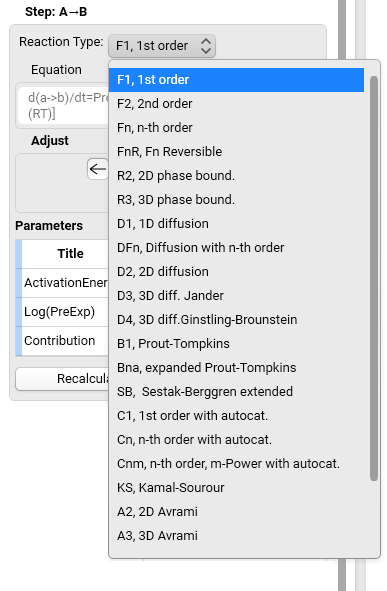Model-Based Analysis: Reaction Types
The rate of chemical reaction for each individual reaction step j can be written as the product of two functions, where the first function fj(ej,pj) depends on the concentrations of reactant (ej) and product (pj). (see also Model-Based: General). The second function Kj(T) depends on temperature.
For all chemical reactions the Arrhenius temperature dependence with activation energy Ej is used:
Kj(T)=exp[-Ej/(RT)]
The dependence on concentrations f(e,p) can be described by the following reaction types (only first elements are shown, use scroll bar to view the rest):

| Code | Function | Type of Reaction |
|---|---|---|
| F1 | f = e | Reaction of 1st order |
| F2 | f = e2 | Reaction of 2nd order |
| Fn | f = en | Reaction of nth order |
| FnR | Reversible reaction of nth order | |
| R2 | f = 2e1/2 | Two-dimensional phase boundary |
| R3 | f = 3e2/3 | Three-dimensional phase boundary |
| D1 | f = 0.5 / p | One-dimensional diffusion |
| DFn | f = en · 0.5 / p | One-dimensional diffusion with n-th order |
| D2 | f = -1 / ln(e) | Two-dimensional diffusion |
| D3 | f = 1.5e2/3 / (1 - e1/3) | Three-dimensional diffusion Jander’s type |
| D4 | f = 1.5 / (e-1/3 – 1) | Three-dimensional diffusion Ginstling-Brounstein type |
| B1 | f = e·p | Prout-Tompkins equation |
| Bna | f = en·pAutocatOrder | Expanded Prout-Tompkins equation |
| SB | f = en·pm · [-ln(e)]q | Expanded Sestak-Berggren equation |
| C1 | f = e·(1 + AutocatPreExp · p) | Reaction of 1st order with autocatalysis by product |
| Cn | f = en·(1 + AutocatPreExp · p) | Reaction of nthorder with autocatalysis by product |
| Cnm | f = en·(1 + AutocatPreExp · pm) | Reaction of nth order with m-Power autocatalysis by product |
| Kamal-Sourour* | ||
| A2 | f = 2e·[-ln(e)]1/2 | Two-dimensional nucleation according to Avrami |
| A3 | f = 3e·[-ln(e)]2/3 | Three-dimensional nucleation according to Avrami |
| An | f = n·e·[-ln(e)](n-1)/n | n-dimensional nucleation according to Avrami-Erofeev |
| Nk | Nakamura crystallization (Avrami + Hoffman-Lauritzen) | |
| SbC | Sbirrazzuoli crystallization (Sestak-Berggren + Hoffman-Lauritzen) |
*Kamal-Sourour (see references [1, 2]):
![]()
In case of projects of type DSC Curing, each reaction step can be described incorporating Diffusion Control.
Related Literature:
[1] S. Sourour, M.R. Kamal, Differential Scanning Calorimetry of Epoxy Cure: Isothermal Cure Kinetics, Thermochimica Acta 14 (1976), 41-59
[2] B. Bilyeu, W. Brostow, K.P. Menard, Epoxy Thermosets and their applications III. Kinetic equations and models, Journal of Materials Education 23 (2001), 189-204